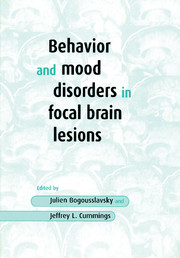Book contents
- Frontmatter
- Dedication
- Contents
- List of contributors
- Preface
- Acknowledgments
- 1 Emotional consequences of focal brain lesions: an overview
- 2 The evaluation of mood and behavior in patients with focal brain lesions
- 3 Methodological issues in studying secondary mood disorders
- 4 Emotional behavior in acute brain lesions
- 5 Depression and lesion location in stroke
- 6 Mood and behavior in disorders of the basal ganglia
- 7 Mania and manic-like disorders
- 8 Behavioral and emotional changes after focal frontal lobe damage
- 9 Disorders of motivation
- 10 Thalamic behavioral syndromes
- 11 Obsessive-compulsive disorders in association with focal brain lesions
- 12 Emotional dysprosody and similar dysfunctions
- 13 Temporal lobe behavioral syndromes
- 14 Neural correlates of violent behavior
- 15 Focal lesions and psychosis
- 16 Alterations in sexual behavior following focal brain injury
- 17 Anosognosia
- 18 Acute confusional states and delirium
- Index
14 - Neural correlates of violent behavior
Published online by Cambridge University Press: 05 August 2016
- Frontmatter
- Dedication
- Contents
- List of contributors
- Preface
- Acknowledgments
- 1 Emotional consequences of focal brain lesions: an overview
- 2 The evaluation of mood and behavior in patients with focal brain lesions
- 3 Methodological issues in studying secondary mood disorders
- 4 Emotional behavior in acute brain lesions
- 5 Depression and lesion location in stroke
- 6 Mood and behavior in disorders of the basal ganglia
- 7 Mania and manic-like disorders
- 8 Behavioral and emotional changes after focal frontal lobe damage
- 9 Disorders of motivation
- 10 Thalamic behavioral syndromes
- 11 Obsessive-compulsive disorders in association with focal brain lesions
- 12 Emotional dysprosody and similar dysfunctions
- 13 Temporal lobe behavioral syndromes
- 14 Neural correlates of violent behavior
- 15 Focal lesions and psychosis
- 16 Alterations in sexual behavior following focal brain injury
- 17 Anosognosia
- 18 Acute confusional states and delirium
- Index
Summary
Introduction
The neurologist Richard Restak has written that ‘there is not evidence … that damage in any area of the brain leads inevitably to a specific violent act.’ This statement is, in this author's view, entirely correct, and it has abundant scientific support. Nonetheless, cases abound in which violent behavior has been attributed largely or entirely to some kind of brain malfunction. Such attributions have become more common than ever in recent years. There are numerous examples in the popular press of mass murderers and other violent criminals who were eventually discovered to have a brain lesion (e.g., tumor); in several cases, this discovery was made after the person had been put to death for a crime. Such examples have attracted considerable sympathy for the notion that some brain-damaged people may not be capable of controlling their violent behavior, and perhaps should even be exonerated for their acts of violent (Cohen, 1998). The issue is not simple, and compelling arguments can be proffered on both sides.
Violent and aggressive behavior1 has been associated with a number of neurological and neuropsychiatric conditions, especially head injury, seizure disorder, and brain tumors, and, to a lesser extent, stroke, Alzheimer's disease and other degenerative conditions, movement disorders (e.g., Huntington's disease), mental retardation, and psychosis (Silver and Yudofsky, 1997). However, the fact remains that in all of these conditions, the vast majority of affected people do notcommit violent acts. Moreover, in cases in which violence does occur, acute situational factors (particularly drug and alcohol intoxication) and constitutional and psychosocial characteristics (e.g., a lifelong history of antisocial personality) nearly always figure in the equation (Goldstein, 1974; Herzberg and Fenwick, 1988). Cases in which a sober, placid, well-adjusted person suddenly goes berserk are extremely uncommon. Also, understanding of the nature of cause-and-effect relationship between brain maladies and violent behavior has been hindered by the fact that a large majority of cases are dominated by thorny legal considerations, and in the course of sorting out the forensic issues, scientific integrity is often stretched well beyond reasonable limits. As Wortis (1990) has put it, ‘interest in the biological determinants of violent behavior should not serve as a means of getting away with murder.’
- Type
- Chapter
- Information
- Behavior and Mood Disorders in Focal Brain Lesions , pp. 399 - 418Publisher: Cambridge University PressPrint publication year: 2000
- 1
- Cited by



